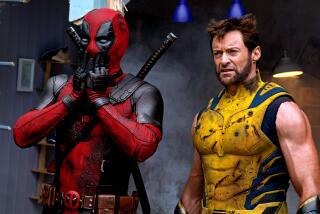Little Doubt About Future of DVD
- Share via
If Hollywood held any lingering doubts about DVD’s breakthrough potential a year ago, they’re gone now.
The digital videodisc format took off like a rocket during its third year, leaving little doubt about its future as a replacement technology similar to the audio CD it closely resembles.
Although DVD still has a long way to go before displacing videocassettes, the format passed several milestones during the last 12 months. The Consumer Electronics Assn. even proclaimed the DVD player in November the fastest-selling consumer electronics product in history.
“I think DVD surprised everyone in the industry with the strength of its growth this year,” said Universal Studios Home Video President Craig Kornblau. “Clearly, it is not going to trickle out like laser [discs].”
In late August, “Titanic” became the first DVD to break the 1-million-unit barrier, quickly followed by “The Matrix,” “Saving Private Ryan” and “Austin Powers: The Spy Who Shagged Me.”
Disney finally deemed the market ripe enough for its animated classics. “Saving Private Ryan” was the first hit director Steven Spielberg approved for DVD release. In yet another first, New Line put “Detroit Rock City” on disc three weeks before videocassette.
“This is a home run,” said Warner Home Video President Warren Lieberfarb, an instrumental force in getting the format off the ground. “Nothing’s going to stop DVD from going all the way.”
Demand rose so quickly that the manufacturing plants pressing the DVDs couldn’t keep up.
DVD sales more than doubled in 1999 over the previous year’s 8.8 million units, according to Video-Scan, whose estimates cover about 70% of the market. Sales are expected to spike further as consumers stock up on discs for players they received as gifts over the holidays.
The hardware base was expected to approach 4.5 million by the end of 1999, and grow to 10 million by the end of this year for a penetration of 10% of the U.S. market. What’s more, computers able to play the software through DVD-ROM drives were projected to hit 10 million by the end of 1999.
By comparison, VCR penetration is 90%.
Warner showed what the format could do when it released “The Matrix” on Sept. 21. Packed with nifty extras and priced at a relatively modest $24.98, nearly 800,000 discs were sold in a week--far more than any previous release--and now the total is more than 2 million. As of mid-December, it was easily VideoScan’s No. 1 title for the year, followed by “The Mummy,” “Saving Private Ryan,” “Austin Powers: The Spy Who Shagged Me” and “Armageddon.”
Those titles appeal to the early adopters, who are typically male. But “Titanic” and “A Bug’s Life,” which also made the top 10, appeal to a broader group, according to VideoScan general manager Tonya Bates.
“You have titles that are demographically wrong for DVD like “Notting Hill” and they’re selling very well, showing the market is expanding,” Kornblau said.
Disney’s changing approach to DVD speaks volumes about the market’s shift beyond early adopters. Long a leader in videocassette sales because of its strong following by children, the studio dragged its heels before embracing the format.
The studio finally unleashed its first wave of animated jewels on DVD in October. By November, Disney had revamped its catalog strategy to capitalize on consumer demand.
Even more intriguing, the studio plans to release two versions of “Tarzan” in 2000--one for families and the other for videophiles--and each stocked with extras geared to the intended audience. That strategy mirrors moves by Universal, which released two collector’s editions of “The Mummy,” followed by rated and unrated versions of “American Pie.”
Each cited the need to cater to different audiences with the decision. “There are two different consumers,” said Buena Vista Home Entertainment general manager Mitch Koch. “There are consumers who want family-laden features and there are film buffs that want behind-the-scenes information.”
But rival studios question the need for two distinct cuts. “I basically believe there should be one version that is feature-laden at a fair price so as to differentiate DVD from VHS and Pay Per View, and thereby provide benefits that are not available in other media to encourage consumers to purchase DVD,” Lieberfarb said.
As the format’s popularity has grown, so have rumors that studios are moving to embrace the same two-tiered rental-pricing model employed in the videocassettes market. Now, DVDs are sold to retailers at one moderate price--allowing them to sell directly to consumers.
By comparison, studios sell retailers videocassettes for rental purposes at much higher prices--and are eager to protect that model and apply it to DVDs should they become a more dominant component of the rental market.
It’s an especially sore subject for retailers struggling to compete with Blockbuster and Hollywood Video, which get breaks from the studios in return for cutting them in on the revenues.
While some executives maintain that a high rental price for DVDs would make it harder for smaller retailers to stock the product, and therefore impede the format’s success, others aren’t sure how pricing will play out. “It’s hard to predict if there will be rental pricing and what that would be,” said Jeff Fink, division president of sales and marketing at Artisan Entertainment.
However, several key executives say privately it is not a question of if, but when the shift occurs. “If the economics change to the point where we find people are taking down a significant amount of space for VHS and replacing something that’s $60-plus for something under $20 [wholesale], I would say it would be inevitable,” one division head said.
DVD sales are starting to cannibalize the rental market, but studios don’t consider it an issue yet. “We see whatever cannibalization occurs on VHS is more than offset by growth of DVD so that by-title profitability has increased measurably,” Lieberfarb said.
“VHS is still a huge business,” said Kelley Avery, head of worldwide video and retail entertainment at DreamWorks SKG. “It’s still the primary business. When you add DVD on top of that, it’s a good time for the category.”
Even the recent break in the DVD encryption code by a 15-year-old hacker in Europe can’t dim enthusiasm for the format’s future, although studios are taking the breach seriously. Nor are executives bothered by the immediate prospect of video on demand, an alternate delivery system Wall Street trots out regularly when predicting the video rental business’ demise.
Their verdict: Not a major threat in 2000, but something to watch down the road.
“It’s still a pimple in comparison to video,” Kornblau said.
“There’s been a lot of discussions out there, but I still think it’s a few years away,” Avery said. “As a studio, obviously we have to look at everything; we look at video on demand, we look at e-commerce and we look at video streaming. The important thing to remember is how robust and vibrant the category is. Any business with multiple formats for consumers, you can’t ask for a better business to be in.”
*
Garrett is a senior editor of Video Business Magazine, a weekly trade magazine based in Los Angeles.
More to Read
The biggest entertainment stories
Get our big stories about Hollywood, film, television, music, arts, culture and more right in your inbox as soon as they publish.
You may occasionally receive promotional content from the Los Angeles Times.










